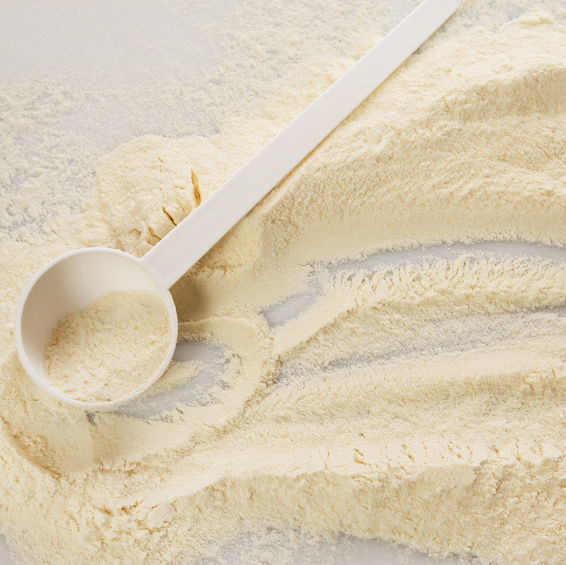Whole Egg Powder
What is Whole Egg Powder?
Whole egg powder is the dried form of whole eggs. It is commonly used as a whole egg substitute in protein-rich baked goods due to its longer shelf life compared to fresh eggs.1
A wide variety of whole egg powder products are commercially available:2
- Standard whole egg
- Stabilized (glucose-free) whole egg
- Free-flowing whole egg
- Special egg mix with carbohydrates
Other commercially available powdered egg products such as powdered egg whites and powdered egg yolks exist for specialized usage.1,2 All dry egg powders need to be hydrated prior to usage in baked formulations.
Origin
Whole egg powder is obtained from the spray dehydration of liquid fresh eggs and the first known process was patented in the US in 1889 by Charles La Mont.1
In the early 1900s, a belt drying method was developed in China to meet the growing demand for egg powder. Commercial egg drying in the US began in the 1930s and has expanded since then. Today, whole egg powder, egg white powder and egg yolk powder are available nationwide and present a long shelf life alternative product to fresh eggs for the production of a variety of food products. 1
Function2
In baked products, eggs perform many functions including:1
- Binding: this property is essential for baked goods texture building.
- Emulsification: is mainly due to the presence of lecithin, an effective natural emulsifier.
- Aeration: eggs produce stable foams when whipped to provide volume build up, lightness and smooth mouthfeel. This is especially important for sponge cakes, genoise and angel cakes.
- Color and flavor: In baked goods, eggs provide a desirable yellow color, characteristic of the yolk carotenoids. Egg proteins also participate in Maillard reactions responsible for desirable flavor and crust browning.
- Other attributes include their effect on reduced staling, enhanced moistness and surface shine (egg wash).
Nutrition
Whole egg powder nutritional value per 100 g:3
| Component | Grams |
|---|---|
| Protein | 55.50 |
| Carbohydrate | 21.80 |
| Lipid | 13.00 |
| Ash | 5.84 |
| Water | 3.86 |
Whole egg powder provides 444 kcal per 100 g. Eggs are an excellent source of high-quality protein. Also, they are a good source of vitamins, minerals, omega-3 fatty acids, carotenoids and other antioxidants.1,3
Commercial production
Whole egg powder can be manufactured through the following process:2
- Cleaning: whole fresh eggs are cleaned before processing
- Cracking: whole eggs are cracked and the liquid is homogenized
- Precooling
- Filtration: the homogeneous liquid is filtered to remove potential impurities (eggshells)
- Storage: the liquid is stored in buffer tanks for further processing
- Desugarization: glucose is removed from liquid whole eggs via bacterial or yeast fermentation to avoid undesirable off-flavors and colors
- Pasteurization: desugared liquid is pasteurized at a temperature of 60 oC (140 oF) for 3.5 minutes to reduce the Salmonella counts to an acceptable level
- Drying: liquid eggs are spray-dried with hot air at a temperature of 110 – 125 oC (230 – 257 oF)
- Packaging: the resulting dried whole egg powder is packed and stored for transportation
Application
Whole egg powder can be used to substitute fresh eggs in several baked goods with good results. When using powdered eggs consider the following:1,2
- Powdered eggs should be added with other dry ingredients. So, adjust water content accordingly in the formulation.
- Powdered eggs should be reconstituted with appropriate amounts of cold water. For better hydration, the reconstituted liquid should be allowed to stand for 1-3 hours prior to usage.
A recommended substitution formula for fresh eggs with whole egg powder is:
100 g of fresh eggs = 26 g of whole egg powder + 74 g of water
Regulations
Whole egg powder is considered GRAS by the FDA when following good manufacturing practices. Some specifications should be met before drying whole fresh liquid eggs and the use of anticaking agents (silicon dioxide at maximum level of 1%) is permitted.4
In the EU, whole eggs (fresh or dried) are regulated by the EU Commission Regulation No 1308/2013.5
References
- Stadelman, William J., Debbie Newkirk, and Lynne Newby. Egg science and technology. CRC Press, 2017.
- Bhandari, Bhesh, et al., eds. Handbook of food powders: Processes and properties. Elsevier, 2013.
- U.S. Department of Agriculture, Agricultural Research Service. FoodData Central, 01 April 2019. https://fdc.nal.usda.gov/fdc-app.html#/food-details/173429/nutrients . Accessed 15 January 2022.
- Food and Drug Administration (FDA). US Department of Health and Human Services. CFR Code of Federal Regulations Title 21, Part 160 Eggs and Eggs Products, https://www.accessdata.fda.gov/scripts/cdrh/cfdocs/cfcfr/CFRSearch.cfm?CFRPart=160&showFR=1#:~:text=(a)%20Dried%20eggs%2C%20dried,They%20may%20be%20powdered.&text=The%20finished%20food%20shall%20contain,by%20weight%20total%20egg%20solids., Accessed 15 January 2022.
- European Commission (EC). Commission Regulation (EU) No 1308/2013 of the European Parliament and of the Council of 17 December 2013 on food additives. Official Journal Of European Communities, 17 December 2013.


